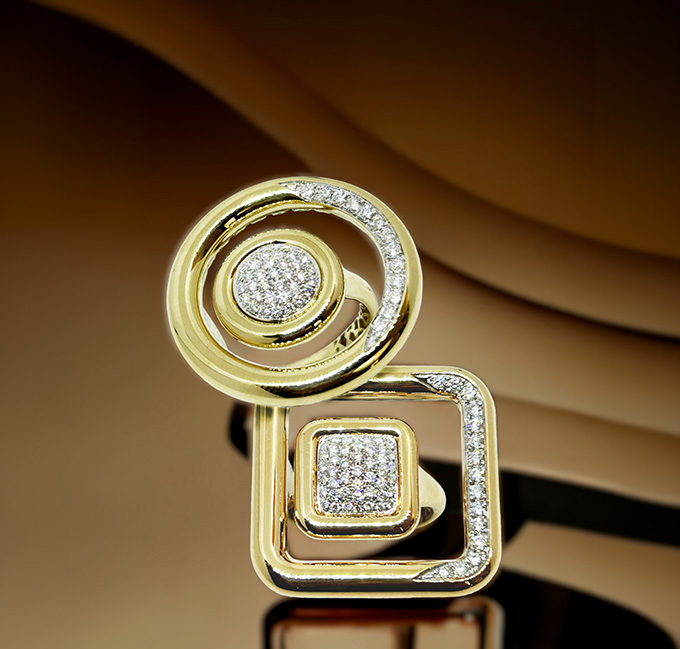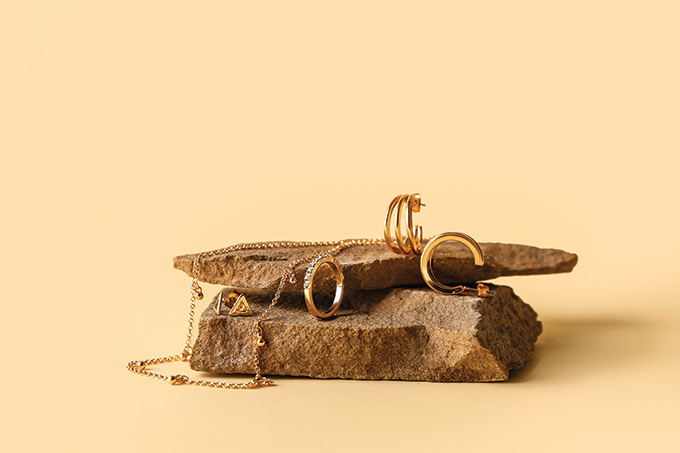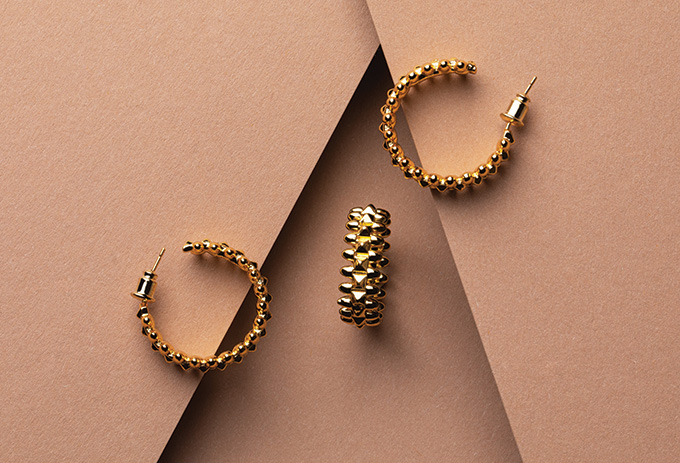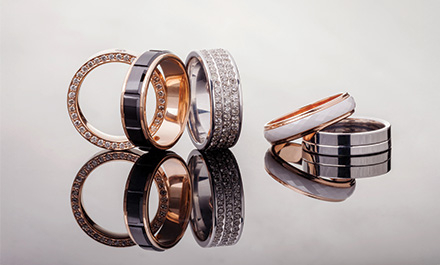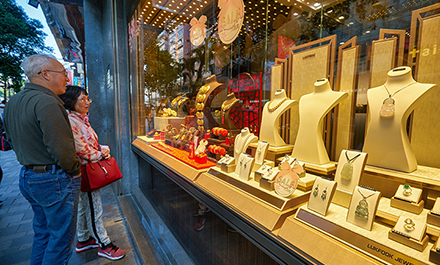The market’s fascination for yellow gold jewellery is gaining steam, leading to a surge in fine jewellery collections that pay homage to the beloved metal’s inherent opulence and versatility. Historically high prices, meanwhile, are reinforcing gold’s monetary worth among value-seeking consumers.
This article first appeared in the JNA September/October 2024 issue.
Favoured for its rich, warm colour and regal appeal, yellow gold has been taking the luxury world by storm. It has dominated fashion runways since the start of the year, with designer brands offering an assortment of mustard-yellow dresses and accessories in their latest collections.
The trend has inevitably trickled down to fine jewellery circles as evidenced by a resurgence in demand for yellow gold jewellery. Among the most influential proponents of yellow gold jewellery are major houses who are redefining modern appreciation for the prized metal.
In the Flames Chapter of Tiffany & Co’s Blue Book 2024: Tiffany Céleste, yellow gold is a critical component that evokes imagery of solar flares and fiery colours.
Yellow gold is also a key element in Messika’s Midnight Sun campaign and in iconic collections from Cartier, Piaget and Boucheron, to name a few. Jewellery manufacturers interviewed by JNA are attesting to this renewed fascination for yellow gold in the trade.
Colour of affluence
Valenza-based Giloro’s Pierpaolo Cervetti said yellow gold is making a strong comeback this year, following a stellar performance of pink gold. The company, which specialises in 18-karat gold jewellery, mainly sells to Asia and Europe.
Giloro’s expertise in yellow gold jewellery manufacturing took centre stage with the launch of its Moonscape Collection earlier this year. Cervetti said, “We use top-quality diamonds of G-H colours and VS clarity grades to add more sparkle to our one-of-a-kind collections.”
The challenge, however, is how to grow the business continuously and consistently amid ongoing uncertainties, he noted.
Joseph Hasbani, partner at Hasbani Gioielli SpA, revealed that the market indeed is showing increased preference for yellow gold, corroborating observations by other industry players. There was a time when white gold was all the rage, he added, but the yellow gold trend tends to last longer.
“Historically, that has always been the case. We can have about 15 years of strong white gold sales, followed by around 50 years of gold prominence. We can expect steadily rising demand for yellow gold,” explained Joseph.
Buyers are also increasingly moving towards everyday pieces in yellow gold and fewer diamonds as opposed to statement jewellery.
Hasbani Gioielli’s main markets are the US and the Middle East, followed by Asia, specifically Indonesia and the Philippines. Its hero products are 18-karat gold jewellery pieces embellished with diamonds and coloured gemstones – all manufactured in its factory in Milan.
Walter Magnaghi, sales manager of Blu Oro Srl, said his company produces mainly yellow gold jewellery. And he is also seeing rising demand for the precious metal, specifically in the company’s key markets of the US, the UK, Japan and Asia.
“White gold represents only 10 per cent of our production while two-toned jewellery is becoming bigger, and now accounts for about 20 per cent. The rest is yellow gold,” explained Magnaghi.
Yellow gold’s rich and stately appeal alongside the soaring prices of gold could be the driving force behind the demand upsurge, he noted. Another contributing factor are celebrities and influencers regularly sporting yellow gold jewellery and accessories in their social media posts.
Based on data from the World Gold Council (WGC), the price of gold has reached US$2,498.60 per ounce as of September 2, 2024, up 29 per cent from US$1,937.20/oz in the same period last year.
Buyers from the US would go for 14-karat gold while those in Hong Kong and Japan are partial to 18-karat gold. Meanwhile, 22-karat gold is highly sought after in Indonesia. Blu Oro also produces lightweight, hollow gold jewellery for its mainland Chinese clients.
With gold prices poised to climb further in 2025, Magnaghi said retailers and wholesalers could be facing challenging months ahead.
“It could be a problem for a few big customers, particularly retailers,” he noted. “It might be difficult to factor in significant and frequent price changes in their budgets at the start of the year.”
Pricier gold, however, will still be attractive to the more affluent customer and to those who consider the precious metal as a form of investment.
Markets with strong cultural affinity for gold such as China and India will also continue to purchase gold even at a premium, he added.
Italy, as a global jewellery manufacturing hub, plays a critical role in the yellow gold jewellery segment. Joseph of Hasbani Gioielli pointed to Italy’s renowned reputation for creativity, exceptional design and product quality as pillars of sustained growth. These are instrumental to further raising the profile of Italian jewellers globally.
“Introducing yourself as an Italian jeweller is already an advantage. The trade commonly associates Italian production with these positive qualities, which will have to be matched with fine-quality jewellery and reasonable prices, of course,” noted Joseph.
Yellow gold is also an integral part of the Indian jewellery industry. While demand was down in the first half of 2024 mainly due to high gold prices, data from WGC points to better days ahead.
According to WGC’s latest Gold Demand Trends report, the government’s decision to cut import duties on gold and other metals is likely to prompt a revival in gold jewellery demand moving forward as more affordable imported gold feeds through to consumers at the retail level before seasonal festive buying begins.
“A healthy monsoon so far should add to the positive momentum in domestic economic growth and further support demand in Q3. However, any further sharp rises in the gold price would likely mitigate the positive effects of the cut in customs duty – at least temporarily – until consumers become accustomed to new, higher levels,” noted WGC.
Cultural significance
Turkish jewellers produce a different kind of gold jewellery – one that is steeped in historical influences and cultural motifs.
According to manufacturers, their focus on design, quality, customisation and affordability sets them apart from other jewellery manufacturing regions.
“Simple and lightweight jewellery is gaining traction in the market,” said Kerem Yoldas of Akhas Jewellery. “We use innovative 3D printers to produce lightweight gold jewellery in unique designs that resonate well with our customers.”
Akhas Jewellery manufactures an extensive selection of gold jewellery, ranging from sets and half sets to bracelets, bangles and rings. Its primary market is the Middle East.
Gold jeweller Kurtulan, meanwhile, is offering 24-karat gold jewellery embellished with sapphires, rubies and emeralds. According to Ismet Naci Kurtulan, CEO of Kurtulan, setting gemstones in pure gold required a special technique developed by the company.
Kurtulan specialises in handmade jewellery pieces in one-of-a-kind designs, which align with heightened appreciation for self-expression and individuality among today’s consumers. Its jewellery pieces are meticulously produced in-house and sold locally and overseas.
The company exports gold jewellery to China, Hong Kong, the Middle East, Korea, Japan, Europe and the US, with each collection specifically tailored to these markets’ diverse preferences.
Customers in the US and the Middle East favour larger, statement pieces with bigger gemstones while Asian buyers, particularly those from China, prefer smaller, finer gemstones set in their jewellery, revealed Naci.
Demand for 24-karat gold remains strong among Chinese buyers due to the metal’s traditional significance while 18-karat gold is more popular in Europe and the US.
Evolving consumer behaviours are mainly influenced by social media, added the company official. One observation is higher demand for jewellery pieces for everyday wear, often driven by the desire to display these pieces on social media platforms.
“It is important to create items that are appealing, possibly substantial in size, and priced very reasonably,” explained Naci. “We combine silver with 24-karat gold to create high-quality pieces at reasonable price points, so people can keep purchasing fresh designs.”
Both Yoldas and Naci pointed to customisation and flexibility in production as key to sustaining their edge in the international market.
Yoldas, however, said Turkish gold jewellery manufacturers are faced with strict government regulations on gold imports to Türkiye. A quota system for unprocessed gold imports implemented by the government in 2023 has severely impacted some Turkish jewellers.
This policy also results in higher domestic gold production costs. The widening disparity between Turkey's domestic gold prices and the international market premium makes setting consistent gold prices for customers all the more challenging.
“This situation is not only affecting our company but also the Turkish jewellery industry as a whole. If this regulation remains in place, we may consider moving production to another country,” continued Yoldas.




